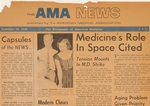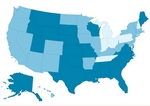business
Commissioners submit simpler explanations of insurance policies to HHS
■ Under the health reform law, plans are required to eliminate the fine print and use an easy-to-understand template to spell out benefits and coverage.
By Emily Berry — Posted Jan. 5, 2011
- WITH THIS STORY:
- » Related content
The Patient Protection and Affordability Act will open up the health insurance marketplace to millions, but insurance jargon in the fine print of health insurance policy documents continues to make that marketplace disorienting to many. So the new law includes measures to simplify insurers' explanations of their products.
Under the reform law, the secretary of the Dept. of Health and Human Services is required to consult with the National Assn. of Insurance Commissioners and a diverse group of interested parties to recommend standard language for health insurance policy documents.
The NAIC convened that group, which included a representative from the American Medical Association, along with consumer groups, insurance companies and health policy experts.
"I think this is a critical piece in making reform work," said Maine Insurance Superintendent Mila Kofman, who co-chaired the NAIC Consumer Information subgroup.
After 120 hours of conference calls and meetings beginning in June 2010, the group approved its submission to the Dept. of Health and Human Services in November 2010.
"The jargon used by insurers to explain health insurance benefits is an obstacle to getting helpful information to patients," said AMA President Cecil B. Wilson, M.D. "The AMA is working to stop insurers from hiding behind complicated rules and policies. Patients deserve clear and understandable information so they know exactly what to expect from their insurers."
The full body of the NAIC voted Dec. 16, 2010, to send the subgroup's sample glossary and summary of benefits and coverage to HHS Secretary Kathleen Sebelius (link).
Beginning in March 2012, insurers will be required to use the glossary and template the secretary approves, including plans that will be sold in health insurance exchanges in 2014.
The glossary defines words such as "usual and customary," "provider" and "skilled nursing care."
Insurers will fill in the blanks in the summary of benefits template with their company names and individual policy details. They are required to use at least 12-point type in the version of the documents that outline policy coverage for customers, ending the use of fine print.
Kofman said the glossary and template don't replace consumer education.
Like nutritional labels, details about things like deductibles and co-pays don't mean anything in isolation -- consumers have to know when they are getting a good deal or not, she said.
"In order for the consumer to use this, for businesses and individuals who buy insurance, you're also going to need to do a lot of educating people about how it really works," Kofman said.












